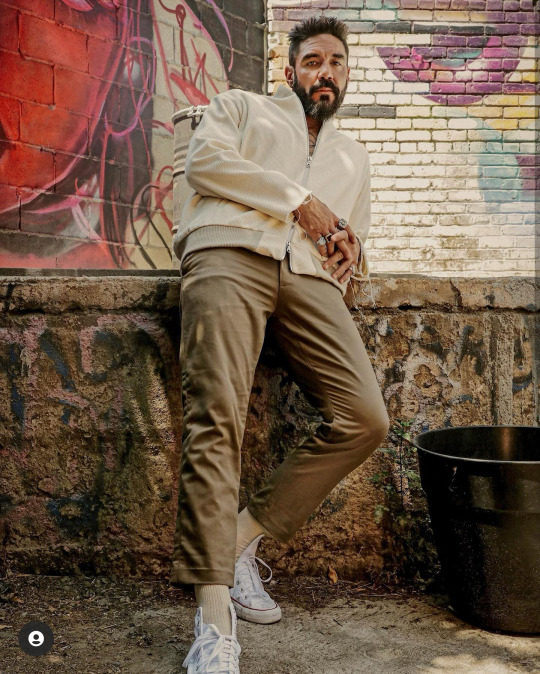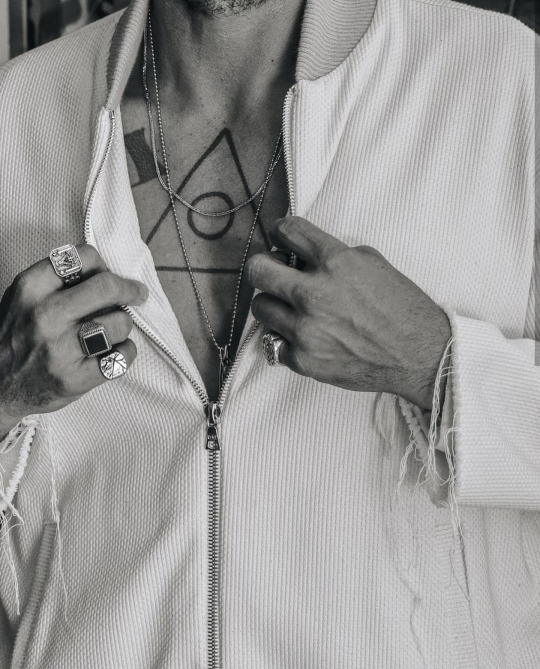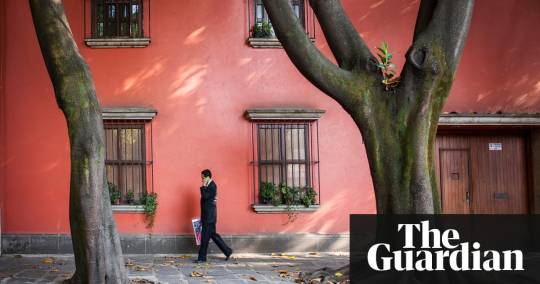#frida takes angel on gallery dates
Text



>> Frida makes Angel her insta-muse part 1/??
#frida takes angel to the city and makes him her insta muse for the weekend#she loves to take photos of his tattoos#even the ones she didnt ink#frida takes angel on gallery dates#he poses for photos begrudgingly#but seriously loves how he looks in her lens#she always finds the bomb lighting#he secretly adores being her muse and preens for her just a lil bit#he tries to see the photos over her shoulder#frida takes angel to random coffee shops and bakeries to try different things#he won't ever admit it but he loves each one more than the last#they share a kiss on a busy street corner#angel x frida vibes#angel x frida#angel reyes x frida#angel x frida -- the good times#loved you once vibes#loved you once#loved you once au#i hear the bells#i hear the bells vibes#angel reyes x reader#angel reyes x oc#my writing#mayans mc#clayton cardenas#mayans mc fic
12 notes
·
View notes
Text
Frida Kahlo’s neighbourhood: exploring vibrant Coyoacán, Mexico City
Ahead of a major Frida Kahlo show at Londons V&A we visit the artists bohemian district from her house to the cantina where she drank, and from arts venues to fantastic markets and restaurants

Coyoacán was once a hard-to-pronounce place, little known outside of Mexico City. Now it is an almost-obligatory destination for most visitors. Blame it on Frida Kahlo-mania. The artist’s birthplace and final residence, now the Museo Casa Azul, is here on a quiet residential street between similar still-private homes built around the turn of the 20th century. The folk art-filled museum, open as such since 1957, now draws queues that snake around the tree-lined block (advance online purchase of tickets is advisable). But this was not always the case.
Self-portrait with necklace by Frida Kahlo, 1933. Photograph: Daniel Leal-Olivas/AFP/Getty Images
On my first visit to this vast capital in 1978 as a student of art history, I wanted to visit the then little-known artist’s house. My guidebook didn’t mention it and my hotel concierge didn’t know of it – nor did the several taxi drivers I queried to help me find it. On that occasion I didn’t get there. And when I finally did, several years later, it was dusty and forgotten; I was the only visitor that day.
A short walk from the Casa Azul is the home where Leon Trotsky lived – and was killed with an ice-pick. The house has been preserved in detail: Trotsky’s bathrobe still hangs on the hook where he left it. It’s the area’s other big draw.
Museo Casa Azul, the Frida Kahlo Museum in Coyoacán. Photograph: Alamy
But it’s worth exploring the neighbourhood beyond these famous homes as there is much more to discover. Coyoacán’s main plaza, cobblestoned and plant-filled, is divided in halves, called Jardín Centenario and Jardín Hidalgo. They form a typical colonial Mexican town square, complete with benches for people-watching, gazebos for music and vendors selling balloons, toys and traditional sweets.
At the eastern side sits the church of San Juan Bautista, a highly gilded baroque affair. Across the plaza to the left of the church is the Casa de Cortés, a large yellow edifice, which occupies the site of Spanish conquistador Hernán Cortés’s 16th-century country home. Corazón de Maguey is an informal restaurant offering Oaxacan and other regional dishes. In the evenings it becomes more of a bar, with a large selection of mezcals. Outside seating affords a good view of the plaza.
Corazón de Maguey, Mexico
Frida and her husband Diego Rivera liked to knock back a tequila or 10 at Cantina La Guadalupana, which opened its doors in 1932. But unlike the equivalent Hemingway hangouts around the world, La Guadalupana has not become an overpriced tourist trap: it retains its old-fashioned working-class charm, bullfighting decor and good service. Free snacks are offered with drinks and there is a serviceable menu of Mexican dishes. The Mercado de Antojitos down the block, is a well known garage-like space; it’s open late and locals stop here for a rich pozole, the hominy-filled stew or a deep-fried quesadilla of cheese, squash blossom or chorizo.
Cantina La Guadalupana. Photograph: Alamy
Coyoacán’s market, a few blocks north (Calle Malintzin between Aguayo and Allende) is where Frida shopped, although the current structure was built in the 1950s, after her death. It still offers a colourful, folksy experience perfumed by flowers, fruits and bubbling pots of spicy mole sauce. In the middle of the market is the renowned Tostadas Coyoacán, with an abundant display of tostada toppings such as prawns, chicken, crab, and spicy pork, piled high and ready to be heaped on a crispy corn tortilla. Order one of the exotic fresh fruit drinks at the adjacent booth for a perfect Mexican lunch.
Heading west from the main plaza, Avenida Francisco Sosa is lined with spectacular colonial-era homes, such as the Italian Cultural Institute and the Casa de Cultura Jesús Reyes Heroles. Across the street is the leafy Plaza Santa Catarina, one of the loveliest spots in the city.
La Casa de los Tacos, Mexico
For a knockout taco experience, head to La Casa de los Tacos. The owners, Hector Ramos, a photographer who runs an art gallery upstairs, and Alejandro Escalante, author of the renowned Tacopedia, have created a thoroughly bohemian vibe. The tacos prehispánicos feature edible insects and are surprisingly delicious. For the less adventurous, there are grilled chicken, beef and pork tacos.
Mercadaroma, meanwhile, is Coyoacán’s answer to the gourmet street market craze. Dozens of stands offer multi-regional Mexican and international foods – and fusions of both – in a smartly designed three-storey building. Try the seafood tacos from the Pacific state of Sonora at Tetakawi or a torta (Mexico’s version of the sandwich), at La Barraca Valenciana.
Mercadoroma
Plaza de la Conchita, a few blocks east of the main plaza (walking down Higuera), is another peaceful park, whose church is one of the oldest in Mexico, dating to the mid-16th century. This architectural gem is a rare example of tequitqui style, which shows the influence of indigenous Indian craftsmen on Spanish baroque architectural ornament.
In addition to architecture-viewing and great eating, Coyoacán offers several other important cultural institutions. The Cineteca Nacional is Mexico’s central film institute, housed in a soaring modern complex where as many as 30 movies are shown on any given day. The Centro Cultural y Social Veracruzano is home to a theatre, shop and El Tajin one of the area’s best restaurants. Down the same road, at no. 134 is the largest branch of Gandhi, Mexico’s major bookseller.
A stroll around Coyoacán makes for a peaceful – and delicious – day out. And a snapshot of Frida’s Mexico.
More Frida-related attractions in Mexico City, and beyond
Diego Rivera and Frida Kahlo House-Studio Museum, San Angel, Mexico City
Photograph: Alamy
Designed by the couple’s friend, the architect and artist Juan O’Gorman, this was Kahlo and Rivera’s first proper marital home. It’s actually two houses joined by a bridge. They lived here from 1934 to 1939 and divorced in that year. Kahlo moved back to the Blue House and when she and Rivera remarried the following year, he moved to join her there, though he kept the San Angel house as his studio. Most interesting for visitors today is the bathroom in Frida’s quarters, which inspired one of her most famous works: What the Water Gave Me – it’s a meditation on her life and her history, as she lay in the tub.
• Admission £1.30, under 13s free, estudiodiegorivera.inba.gob.mx
Xochimilco and Museo Dolores Olmedo, Mexico City
Colourful boats at the Floating Gardens in Xochimilco. Photograph: Alamy
The floating gardens of Xochimilco have been Mexico City’s favourite way to spend a Sunday for many decades, as shown by the photographs of Kahlo trailing her hand into the water from her boat. It’s still the best place to soak up the vibrant, colourful and musical culture of the Mexico Kahlo loved. Rent a boat and be ferried through canals awash with mariachi bands, tortilla- and taco-makers, beer and tequila sellers. Afterwards head for the tranquillity of the Museo Dolores Olmedo Patino, a 17th-century mansion once owned by a friend and patron of Rivera’s. As well as many works by him it contains important paintings by Kahlo, although they’re on loan to an exhibition in Milan until the summer.
• Admission £3.75, free entry on Tuesdays, museodoloresolmedo.org.mx
Museo de Arte Moderno, Mexico City
Photograph: Francesca Yorke/Getty Images
Kahlo’s painting The Two Fridas features in the museum’s collection of 20th-century Mexican art. The museum is currently showing more than more than 200 works by British artist Leonora Carrington (until 23 September). Carrington arrived in Mexico City in 1942, and was based there until her death in 2011. She knew Kahlo and was friends with English millionaire Edward James, a patron of surrealist artists and creator of Las Pozas sculpture garden in the jungles of San Luis Potosí. The exhibition includes discoveries such as a colourful 22-piece set of tarot cards, intricate paintings and tapestries never shown before as well as her best-known works including her self-portrait borrowed from the Met, and her 1947 painting The Giantess.
• Admission £2.40, free on Sundays, museoartemoderno.com
Cuernavaca
Interior of the Robert Brady Museum. Photograph: Alamy
Soon after their first marriage (in 1929), Kahlo and Rivera went to live in Cuernavaca, around 90km south of Mexico City, borrowing the home of the US ambassador to Mexico where they lived while Rivera was painting murals in the town’s Palacio de Cortés. They depict the atrocities committed against the indigenous people, and the Mexican Revolution, and are a macro take on the world, in contrast to Kahlo’s micro take. The Robert Brady Museum is one of the best artistic highlights of the city and contains work by Kahlo and Rivera.
• Admission £1.80, museorobertbrady.com
Joanna Moorhead
from All Of Beer http://allofbeer.com/frida-kahlos-neighbourhood-exploring-vibrant-coyoacan-mexico-city/
from All of Beer https://allofbeercom.tumblr.com/post/184238359442
0 notes
Link
Artists: Arthur Jafa with Ming Smith, Frida Orupabo, Missylanyus
Venue: Serpentine, London
Exhibition Title: A Series of Utterly Improbable, Yet Extraordinary Renditions
Date: June 8 – September 10, 2017
Click here to view slideshow
Full gallery of images, press release and link available after the jump.
Images:
Images courtesy of Serpentine, London. Photos by Mike Din.
Press Release:
Featuring Ming Smith, Frida Orupabo and Missylanyus. The Serpentine presents the work of the acclaimed US filmmaker, cinematographer and artist Arthur Jafa. Across three decades, Jafa has developed a dynamic, multidisciplinary practice ranging from films and installations to lecture-performances and happenings that tackle, challenge and question prevailing cultural assumptions about identity and race.
“How do we imagine things that are lost? What kind of legacy can we imagine despite that loss and despite the absence of things that never were?” Arthur Jafa
Jafa’s work is driven by a recurrent question: how might one identify and develop a specifically Black visual aesthetics equal to the ‘power, beauty and alienation’ of Black music in US culture?
This new exhibition, titled A Series of Utterly Improbable, Yet Extraordinary Renditions, takes the form of a site-specific installation at the Serpentine Sackler Gallery in which Jafa has transformed the space with a series of new assemblages that encompass film, photography and found footage. The title of the exhibition relates to the sense of absence that Jafa observes as haunting Black life. The word ‘rendition’ refers to the artist’s interpretation of the aesthetics associated with Black being, which are historically-inscribed in images, objects and artefacts. By re-performing these narratives in the present, Jafa imagines and constructs new possibilities for making them visible. In addition to his exhibition at the Sackler Gallery, Jafa will also devise a new, site-specific event as part of the 2017 Park Nights series, which takes place in the Serpentine Pavilion, this year designed by Francis Kéré.
Jafa creates work that approximates the radical alienation of Black life in the West while seeking to make visible or emancipate the power embedded in modes of African expression. With reference points ranging from Fang sculpture to Mississippi juke joints, Duchamp’s urinal to jazz, he is a filmmaker with a unique understanding of how to cut and juxtapose a sequence to draw out maximum visceral effect. Jafa works from a set of source books of images he has been assembling since the 1980s and this ongoing archive has proved an enduring resource for works such as the Picture Books, the new films premiering in this exhibition and Love is the Message, The Message is Death (2016), which was shown at Gavin Brown’s enterprise, New York, last year and at MOCA, Los Angeles (2017).
Originally trained as an architect, Jafa made his cinematic debut as Director of Photography for Julie Dash’s 1991 film Daughters of the Dust, for which he won best cinematography at the Sundance Film Festival. As part of the BFI’s season Unbound: Visions of the Black Feminine, a new restoration of Daughters of the Dust will be released at selected cinemas across the UK on Friday 2 June to mark the film’s 25th anniversary – see the BFI website for times and locations.
Jafa has also collaborated with directors ranging from Spike Lee (Crooklyn, 1994) to John Akomfrah (Seven Songs for Malcolm X, 1993) and artists including Kara Walker and Fred Moten. He has also been recognised for his work on the Solange Knowles videos, Don’t Touch My Hair and Cranes in the Sky (2016). Explaining his favourite medium, Jafa has said: ‘Film is one of the few things, particularly in the theatrical context, that takes up as much space as architecture but like music is fundamentally immaterial.’
A Series of Utterly Improbable, Yet Extraordinary Renditions transforms the Serpentine Sackler Gallery into an immersive assemblage of still and moving images. The exhibition also includes the work of three additional voices: the photographer Ming Smith, @nemiepeba – the Instagram feed of artist Frida Orupabo – and content from the YouTube channel of Missylanyus. Together, these three ‘platforms’ or ‘guests’ are integral to Jafa’s presentation throughout the Gallery, and acknowledge the influence of others’ work within his own practice.
Link: Arthur Jafa at Serpentine
Contemporary Art Daily is produced by Contemporary Art Group, a not-for-profit organization. We rely on our audience to help fund the publication of exhibitions that show up in this RSS feed. Please consider supporting us by making a donation today.
from Contemporary Art Daily http://bit.ly/2wz5mKb
0 notes